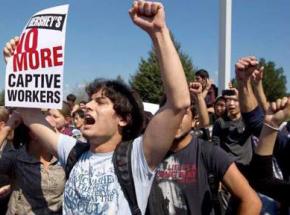Slave labor and the chocolate factory
reports on the protests by foreign students working in a Hershey's packing plant--and the support their struggle has attracted from activists.
REMEMBER WILLY Wonka and the Chocolate Factory? Even as a kid, something bugged me about the Oompa-Loompas, beyond the whole terribly insulting and offensive portrayal of little people.
As Gene Wilder, playing Willy Wonka explained, the Oompa-Loompas were a people who Wonka took from their native land, supposedly to protect them, and housed them in his factory, where they worked diligently for him, making chocolate. As far as I could tell the Oompa-Loompas received no other pay than what was needed to house and presumably feed them. This was rather disturbing.
It's even more disturbing how sometimes life can imitate art.
It was presented as such a nice idea: Young students from places like China, Nigeria, Romania and Ukraine could come to the U.S. on a J-1 summer visa program for cultural exchange to see the sights, immerse themselves in American culture, and work a little. In one video, participants expressed their interest in improving their English, befriending some people they wouldn't normally get a chance to meet, and learning to play baseball.

Because this is America, however, they had to pay for the right to come here and work--anywhere from $4,000 to $6,000.
When they got here, many found themselves working in a Hershey's chocolate packing facility in Palmyra, Pa. The promise of the J-1 visa was that the students would work for a few months, and then get to travel.
Instead, what they got were terrible working conditions and even worse pay. "There is no cultural exchange, none, none," said Zhao Huijiao, an undergraduate in international relations from China. "It is just work, work faster, work."
The hours were long, far exceeding 40 hours a week, with many night shifts of backbreaking work at breakneck assembly line speeds. Although the students were supposedly paid the same as (non-union) American workers, fees for the program and grossly overpriced housing were deducted from their checks.
At the end of months of hard work, the students were left with less money than they started off with. Those who complained were threatened with deportation.
On August 17, the students had had enough. Hundreds of them walked out of their jobs and began picketing the factory, chanting in different languages and waving signs that read "Hershey's: No more captive workers."
THE J-1 cultural exchange visa is organized by the State Department's Council for Educational Travel, which in essence means that the government itself is acting as a supplier of indentured servants from foreign countries for big corporations.
The chief executive of the council, Rick Anaya, even had the gall to claim in an interview with the New York Times that the State Department normally "would go out of our way to help [the students], but it seems like someone is stirring them up out there."
The students came wanting to learn about American culture, and they got to meet the wrong end of American capitalism. In the eyes of Hershey's, these students are cheap workers. But in their own eyes, they're people with dreams and aspirations that don't include being scammed and exploited.
When some 400 international students, accompanied by local labor leaders, halted production on August 17, police predictably showed up and arrested some of those protesting, including AFL-CIO Pennsylvania State President Rick Bloomingdale. As Bloomingdale told the student workers, "The workers of Pennsylvania are with you. The fight for good jobs isn't just your fight, it's our fight."
The walkout has continued. At first, Hershey's tried to pass the buck, pointing to the fact that they subcontract the staffing of packing facilities to a company called Excel, which itself sub-contracts to the State Department in order to get cheap labor.
But on August 24, when four separate government agencies--including the Occupational Safety and Health Administration and the Department of Labor's Wage and Hour Division--announced investigations of working conditions at Hershey's, the company suddenly had a change of heart, announcing it would offer the student workers paid vacations.
As Saket Soni, executive director of the National Guestworker Alliance, which has been helping the students, summed up the reaction to Hershey's "great compromise": "Pennsylvanians know that Hershey's has pursued a deliberate strategy of outsourcing, downsizing and subcontracting for the cheapest, most exploitable workers for decades. That's Hershey's record of brutal corporate greed, and no eleventh-hour offer can cover it up."
The student guest workers have seen abject exploitation, a brutal workplace regime, a corporate-controlled government and a scam poorly disguised as the "American Dream." That is one side of this country. But they have also seen the other side in the outpouring of solidarity from labor unions, other Hershey's workers, the unemployed and local Pennsylvanians.
As these activists and supporters know, the slogan "An injury to one is an injury to all," isn't just a nice phrase--it's a fact. The ruling class will always attempt to use the conditions and wages of those that are the worst off to set the tone for the rest. By lowering the bottom rung, they lower the whole ladder. The call for just and living wages for these student workers is a demand that all workers deserve.


